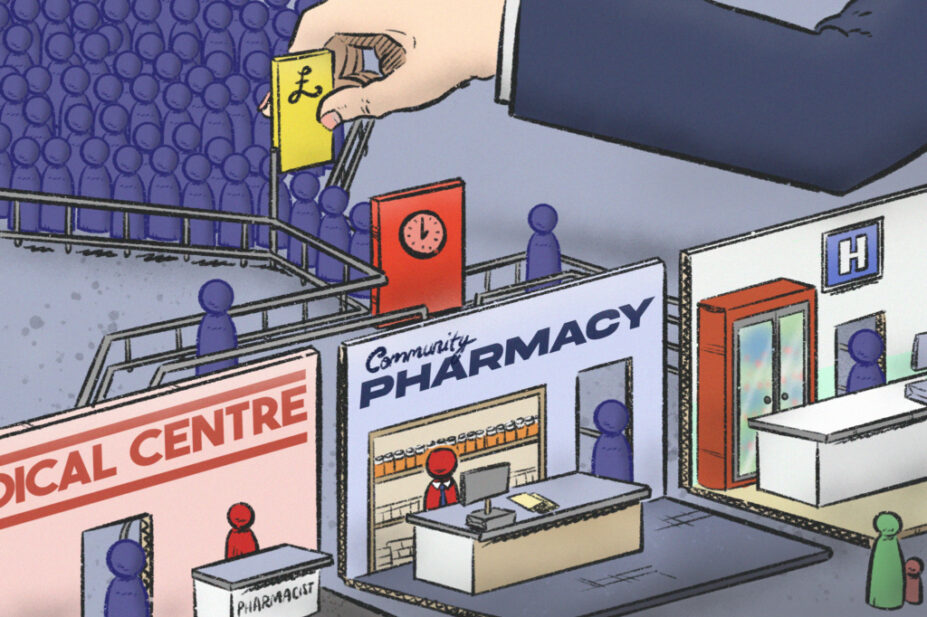
Wes Mountain/The Pharmaceutical Journal
The ‘NHS long-term workforce plan’, published in June 2023, did not shy away from big promises.
Its headline figure of increasing pharmacist training places to almost 5,000 by 2031/2032 suggests a genuine desire to beef up the numbers of pharmacists practising in England.
The plan envisages a staggered increase in the number of trainees, with 3,849 new training places in 2026, 4,098 in 2027 and 4,307 in 2028, culminating in a training intake of 4,970 in 2031.
While the initial reaction from pharmacy bodies was largely positive, praising the plan’s commitment “to investing in pharmacy education and training”, questions were later raised around how the plan will be implemented.
In a statement, the Pharmacy Schools Council (PhSC), which oversees university pharmacy programmes, said that, while several universities were considering establishing new MPharm courses over the next few years to train the extra pharmacists, “greater capacity in all pharmacy sectors will be required to accommodate placements for future undergraduate students”.
However, the 2022 ‘Community pharmacy workforce survey’, published on 3 August 2023, paints a concerning picture.
Since the 2021 survey, vacancy rates have doubled to 16% across the sector, with 44% of contractors — on average, across the 42 integrated care systems in England — describing it as “very difficult” to fill these vacancies.
Dwindling pipeline
The short-term pipeline of pharmacists into community pharmacy also appears to be drying up. The 2022 survey revealed that there were 1,419 full-time equivalent (FTE) foundation year pharmacists in post in community pharmacy – 20% fewer than the 1,765 FTE preregistration pharmacists, as they were previously known, that were counted in the 2017 survey.
The workforce survey also revealed that, on average, only a third of pharmacies responded that they are willing to be identified as employing foundation year pharmacists.
While this was a new question for 2022, suggestions from community pharmacy representatives are that this proportion is trending downwards in parts of the country.
In evidence submitted to the House of Commons Health and Social Care Select Committee’s pharmacy inquiry, Community Pharmacy Lincolnshire said it has already seen community pharmacies withdraw from offering foundation training because of the “significant burdens” it places on community pharmacies, adding that plans to roll out multi-sector placements and independent prescriber training as part of this “also present significant concerns in the future”.
Under the updated standards for initial education and training of pharmacists, published by the General Pharmaceutical Council (GPhC) in January 2021, all pharmacists will be qualified as independent prescribers at registration by 2026. The standards also emphasise expanding foundation pharmacists’ experience, stating that “trainee pharmacists must be exposed to an appropriate breadth of patients and people in a range of environments”.
Although the reality is that community pharmacy is the engine room for the training of registered professionals for the whole system, the support available to them is poor
Tania Farrow, chief officer at Community Pharmacy Suffolk
NHS England guidance for trainees and designated supervisors of foundation year pharmacists recommends trainees spend at least 13 weeks in a particular setting. The organisations hosting the foundation pharmacists are able to determine whether those weeks are offered as one block or multiple smaller blocks, with trainees rotating between settings from week to week.
The guidance adds that the GPhC requires six months of foundation training to be patient-facing in hospital or community pharmacy. The rest of the year can be spent in other sectors, including general practice, industry or commissioning organisations.
However, implementation of the guidance has only just begun and the community pharmacy workforce survey for 2022 shows that, around the country, on average, just 5% of foundation pharmacists are currently on multi-sector placements.
For some local pharmaceutical committees, such as Community Pharmacy Somerset, where vacancy rates were highest at 32%, using these cross-organisational training places is part of a plan to make community pharmacy more attractive and ultimately quadruple the number of trainees in the area by 2026.
In other regions, the prospect of offering this style of training is more challenging. Co-ordinating these changes to pharmacists’ training will create “a significant administrative and training burden” that may cause organisations to withdraw from supporting pharmacist trainees, the evidence from Community Pharmacy Lincolnshire said.
“We have already seen several community pharmacy organisations cease to offer foundation training places within the current approach, and the future methods place an even greater cost and time burden on employers. This therefore needs some careful rethinking.”
The experience in Lincolnshire has been replicated elsewhere.
“This has been exactly our experience,” says Tania Farrow, chief officer at Community Pharmacy Suffolk.
“The east of England has one of the most acute workforce challenges in the country and we have done a considerable amount of work to underpin workforce development. We have had great local engagement from ICBs [integrated care boards], creating robust workforce strategies across all pharmacy sectors. However, unpicking funding flows and the support currently available in order to implement these strategies has really highlighted a range of issues,” she says.
“Although the reality is that community pharmacy is the engine room for the training of registered professionals for the whole system, the support available to them is poor and there is a lack of funding equity across sectors. This is something that needs to be urgently addressed if we are to develop the pharmacy workforce of the future.”
According to the community pharmacy workforce survey, the east of England has a 17% vacancy rate, higher than the national average of 16%. Only the south-west of England has a higher proportion of vacant positions at 21%.
Moving out of community pharmacy
The recruitment struggles in community pharmacy have, in part, been blamed on the Additional Roles Reimbursement Scheme (ARRS) by pharmacy representatives, with NHS Digital figures showing that primary care networks had recruited 5,061 pharmacists through the ARRS scheme as of June 2023.
Both the National Pharmacy Association and the Company Chemists’ Association expressed “doubt” over the impact of the NHS Long-term Workforce Plan’s commitment to an “expansion” of the scheme through to 2036/2037.
“ARRS only makes sense if it is adding capacity to the primary care system, not stripping capacity from other community and secondary care settings,” they said, adding that they “have consistently called for the impact on community pharmacies to be mitigated”.
Other reasons for the growing workforce crisis have included burnout, lack of protected learning time and abuse from patients, with a survey of 1,496 pharmacists carried out by the Royal Pharmaceutical Society in 2022 finding that three-quarters of pharmacy staff had considered leaving the profession as a result.
“I think many pharmacy owners will have to make difficult decisions about whether to take on a trainee, says Reena Barai, who trains pharmacists at SG Barai Pharmacy, which she runs in Sutton, London. “This will be based on current staff in the pharmacy, time needed to train and support trainees, funding for the placement. With many owners at breaking point, I think some will not take up the option of hosting a trainee.”
“I think that will be a shame as we need pharmacists coming into the profession to understand the role and value of community pharmacy in particular,” she says.
The current workforce challenges do make providing quality placements more difficult, especially if there isn’t a consistent team in place
Janice Perkins, non-executive chair of Community Pharmacy Greater Manchester Local Pharmaceutical Committee
“The current workforce challenges do make providing quality placements more difficult, especially if there isn’t a consistent team in place,” says Janice Perkins, non-executive chair of Community Pharmacy Greater Manchester Local Pharmaceutical Committee.
When it comes to providing foundation training placements, Perkins says that “it’s likely that some providers will be considering their position”, but adds that “it’s not just foundation placements, it’s the experiential learning placements that are required as well now that the degree course is changing”.
Education and training
In April 2022, the Department of Health and Social Care announced that pharmacy would be added to the ‘Education and Training Tariff for England’. This means that employers providing MPharm placements now receive nationally-standardised funding at £5,000 per FTE placement, plus a market forces factor, which accounts for cost differentials around the country.
But to access this funding, NHS England’s Workforce, Training and Education Directorate are overhauling experiential learning placements for MPharm students, moving students “from observing tasks to being entrusted to carry them out”.
The latest guidance for placement providers and universities advised that MPharm students could be dispensing medicines, investigating medication errors and administering immunisations to patients as part of these new placements.
“These changes require careful co-ordination and great planning to ensure that students get the best from their placements whilst the pharmacy team continues to deliver great care and the additional services announced in the [primary care] recovery plan,” says Perkins.
While community pharmacy may struggle to meet the demands of training additional pharmacists, the clinical tariff has also raised concerns about the availability of pharmacy placements in general practice.
The pharmacy tariff is well-surpassed by the £30,750 received by practices for taking on medical students, leaving universities concerned that GPs will offer fewer placements for pharmacists.
The PhSC told The Pharmaceutical Journal that it has raised the issue with NHS England’s Workforce, Training and Education Directorate, but said “there is little likelihood the tariff rate for pharmacy will be changed”.
Ade Williams, superintendent pharmacist at Bedminster Pharmacy in Bristol, says the pharmacy sector is facing a balancing act of safeguarding the profession’s future, while supporting the current workforce “through urgent, transformative, professional change”, which may require some innovative thinking.
“We certainly now need to address the status quo, with a focus on practical solutions. We must increase training capacity across the profession,” he says.
“Can tutors take on more than one trainee? Does the length of time post qualification that’s needed to be a tutor need reviewing? And how do we create quality frameworks aligned to professional direction and aspiration?”
While concerns linger over whether there is enough time and people to train more pharmacists in community pharmacy, the first wave of new recruits is fast approaching.
Figures from the Universities and Colleges Admission Service, published in July 2023, show the number of students applying to study pharmacy rose by 28% in the past year, from 25,670 in June 2022 to 32,850 in June 2023, demonstrating a willing potential workforce if the training system can be expanded sufficiently.
“Community pharmacy wants to do more,” says Alastair Buxton, director of NHS services at Community Pharmacy England.
“But, for this to happen, there needs to be a stable, long-term sustainable funding commitment that will enable pharmacies to invest for the future, particularly in their staffing.”


